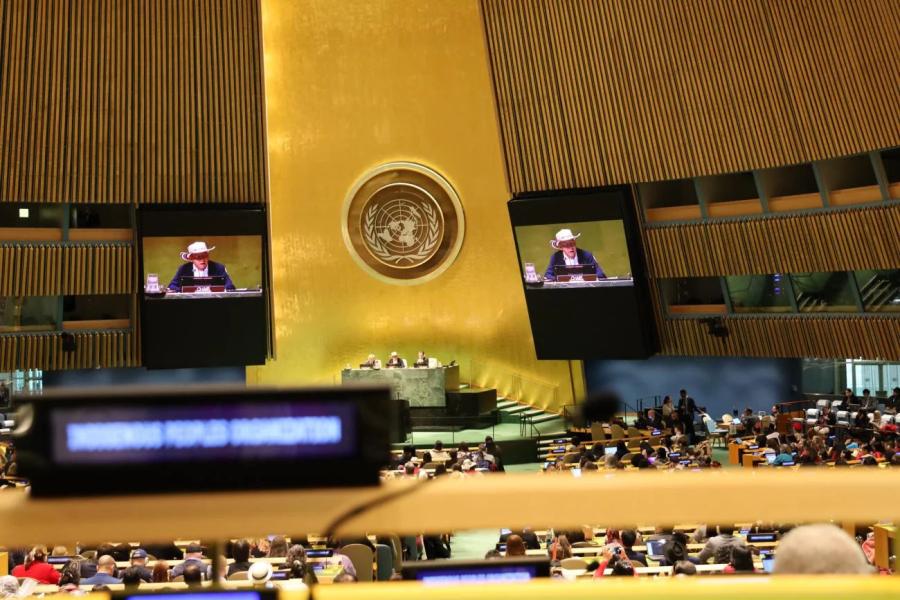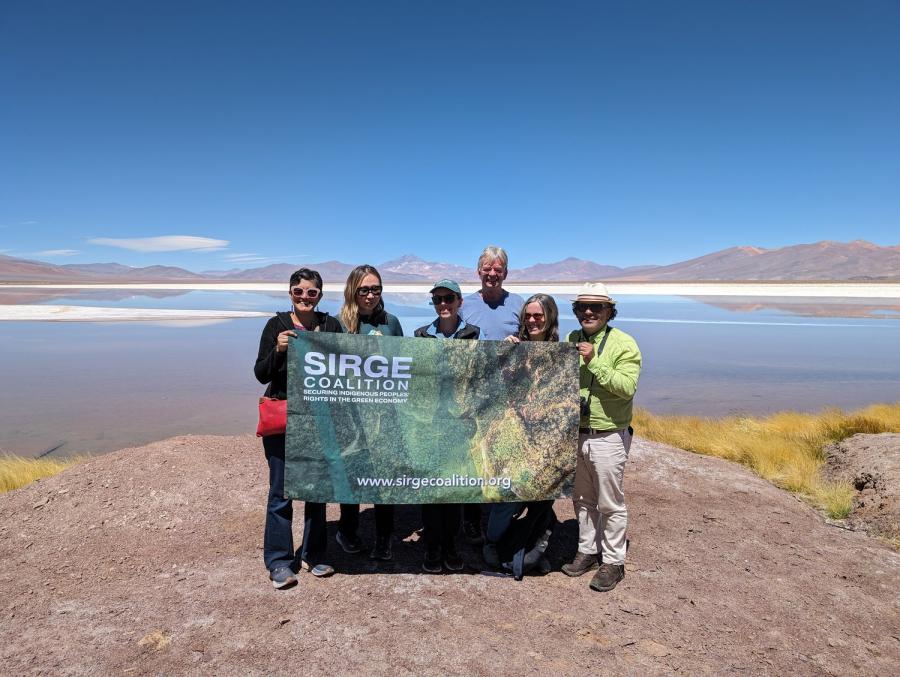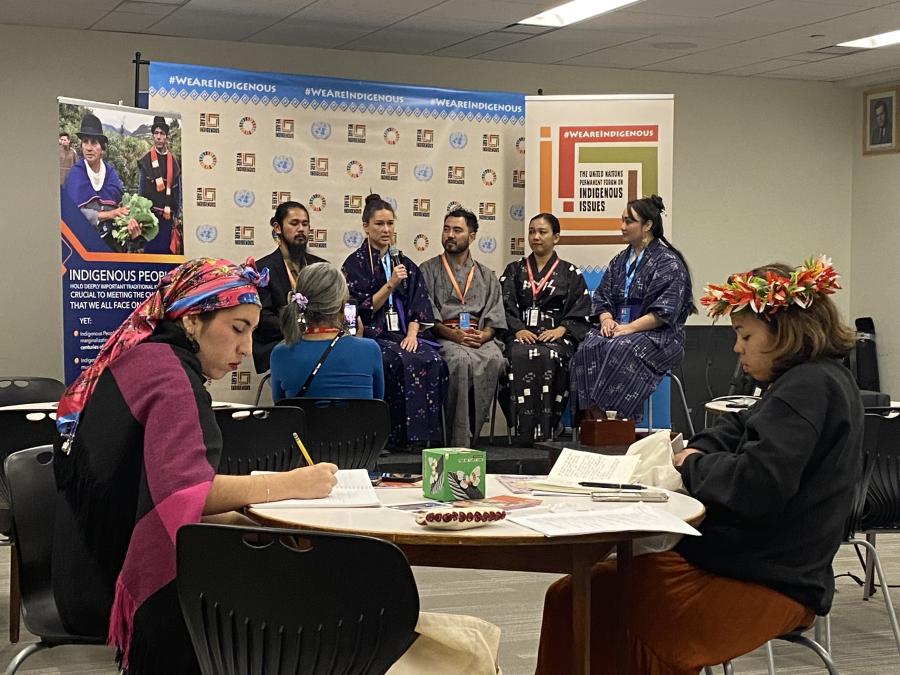Among the states of the United Nations, the ones that have concerns about the Declaration on the Rights of Indigenous Peoples tend to focus on three elements: the lack of a definition of “indigenous,” land rights, and the concept of self-determination. For those states, these elements seem to threaten economic and political chaos on several fronts. But that is largely because states do not entirely understand what it is indigenous peoples are seeking. To help dispel fears and misapprehensions, we asked four indigenous leaders to talk about their understanding of the terms of the declaration and to reflect on what the practical implications would be if the declaration is adopted by the United Nations and implemented around the world.
Les Malezer, native Australian of the Gabi Gabi community, is the general manager for the Foundation for Aboriginal and Islander Research Action in Woolloongabba, Australia. He also is the chairperson for the international Indigenous Peoples’ Caucus. He has been the prime lobbyist at the United Nations for the declaration and is a member of Cultural Survival’s Program Council.
Naomi Kipuri is an anthropologist and the director of the Arid Lands Institute, which grew out of the Arid Lands and Resource Management Network, a regional project on pastoralism in Eastern Africa. She is a member of the Working Group on Indigenous Peoples/Communities of the African Commission on Human and Peoples’ Rights. She also is on the advisory board of the Kenya National Commission on Human Rights and the Technical Advisory Council on Land Policy.
Ramona Peters (Nosapocket of the Bear Clan) is a Mashpee Wampanoag from Cape Cod, Massachusetts. She is a nationally known artist who has revived her tribe’s traditional pottery-making techniques. She is a teacher, spokesperson, curator, interpreter, consultant, and indigenous rights activist. She also is a member of Cultural Survival’s Program Council.
Stella Tamang was chair of the International Women’s Caucus at the third session of the Permanent Forum on Indigenous Issues and is the chair of the South Asia Indigenous Women Forum and an advisor of Nepal Tamang Women Ghedung. She founded Bikalpa Gyan Kendra in Nepal to provide an education and contribute to students’ livelihood by combining book learning with practical skills. She also is a member of Cultural Survival’s Program Council.
Cultural Survival: The declaration does not have a definition of who is indigenous. How can a state know to whom the rights in the declaration should apply?
Naomi Kipuri: I think sensitive governments should not talk of definitions; I think they should talk of the actual situation of indigenous peoples in their countries. You don’t have to define an elephant to know what it is. And in fact, that is what our experience as members of the African Commission on Human and Peoples Rights Working Group of Experts on Indigenous Populations/Communities has been. Sensitive governments have asked the right questions and have gotten the right answers. They then have dealt with the problems in their own areas. When the working group conducted a sensitization seminar in September 2006 in Cameroon, there was resistance in the beginning, but Cameroon is now one of the supporters of the declaration. And it didn’t take too long or too much effort; it just took thinking and listening and hearing. So I think we should enlighten resistant states with information, facts, and the reality within their own countries. Tell them not everything can be defined. Just listen to the issues that these peoples are talking about. These are the issues that go beyond a definition.
Take my case. I am Maasai. Our situation—whether political, social, or cultural—is similar to that of indigenous peoples all over the world. We have lost our lands and our resources; we’re not quite recognized within our state which is always trying to transform us into farmers or whatever else. We’re not included in policy discussions. There is constantly a lack of consultation, even on matters touching on our own livelihoods. We’re marginalized in almost everything. We don’t have health services; we have very few educational resources; we have none of the infrastructure to which all people should be entitled. In a lot of ways, we’re dependent on natural resources that are being expropriated. These are the things that need to change in order for us to enjoy the rights in the declaration.
Stella Tamang: In the case of Nepal, indigenous peoples would be those peoples who were living in a specific territory with their own control before the region was conquered by outsiders. We know who owned the land before the present Nepal was created.
Les Malezer: In Australia there is a clear demarcation between who was here before 1788 and who was here after. What we’ve always maintained in Australia is that indigenous peoples are the original tenants of the country who are tied spiritually and legally to their country. That is, we identify ourselves by our country and our relationship with that country. That definition doesn’t always work elsewhere around the world.
Cultural Survival: Let’s turn now to land rights. How do you see your community’s land, and why is land so important to you?
Stella Tamang: Not all indigenous groups have geographical territory—some have cultural territory. But suppose we are talking about indigenous peoples with historic, cultural, and linguistic connections to their land. They have an intimate connection to the land; the rationale for talking about who they are is tied to the land. They have clear symbols in their language that connect them to places on their land. For example, in Nepal we have groups that only can achieve their spiritual place on the planet by going to a certain location.
Ramona Peters: I’d like to think that we can still draw strength from the land, regardless of who lives there, although a lot of my people don’t feel that way. They see other people’s houses in our territory and they see that land as dead or corrupted. I disagree with that. But the relationship between land and identity is still very strong, to the point where overdevelopment devastates us emotionally. Eight-two percent of our adult men are diagnosed as being depressed. We grew up in a fishing, hunting, and planting society that has been transformed into a lost group of people. Now we have health issues that we did not have 25 years ago. Not being in control of the land, or not being able to protect it or have access to the natural foods and medicines that grow on it, gives us a really shaky future.
Stella Tamang: Our lands are the places where we get our medicines, where we might know about some special plant.
Ramona Peters: For us, it’s access to natural resources—foraging, access to waterways and fishing grounds. People try to block us with private-property signs or by telling us that the clams are their pets. They call the police any time natives are in the area. One of the few reasons that I would be an advocate for federal recognition is the partnership it would provide to protect the land from pollution and random dumping. That dumping is now sometimes state sanctioned or town sanctioned: dredging up one area to make a marina and dumping material on what might seem like a vacant lot. But that lot is not vacant. There are things that live there, things that we use and that others don’t.
Stella Tamang: Free prior and informed consent, which the declaration requires states to get from indigenous peoples before taking action affecting them, is essential. Consider the Sherpa on Mt. Everest. Mountaineering is something that should be governed by Sherpa people. They receive no benefit from the number of people who come to climb, nor do they control the criteria. Sherpa feel that people die there because they are failing to respect the mountain. It is immoral for people to climb the mountain to “conquer” it because the mountain should be respected. The Sherpa should get the benefit as well as the decision-making authority to decide who climbs the mountain.
Cultural Survival: What should be the basis for determining which lands are subject to the rights in the declaration?
Naomi Kipuri: Indigenous peoples know their territory, all the way back to the pre-colonial period. But deciding on the cut-off point to determine ownership is the question which would have to be agreed upon between the indigenous peoples and the government. In fact, in Kenya, according to the new land policy that is currently being drawn up, 1885 has been proposed as the cut-off date. Different people have given different dates, but it is possible to propose a date and to agree upon it. It is not so difficult.
Ramona Peters: In the United States there are already laws on the books that define Indian territories. That definition is based on ancestral homelands. Wampanoag people had a nation that was once 69 tribes, and there are only 3 tribes left: Aquinnah, Herring Pond, and Mashpee. We three tribes can probably claim all the Wampanoag homelands, straight into Rhode Island. We could legitimately claim the city of New Bedford, but we’re not doing that. You end up with “tribal lands,” which are basically the lands you’re living on. So the Aquinnah Wampanoag may have claimed all of the homelands (several counties), but they end up with a little village, a tribal footprint, at the far end of Martha’s Vineyard.
Cultural Survival: What about a situation where traditional lands are now occupied by non-indigenous people? What should happen to those people and that land?
Les Malezer: That’s in Article 46 of the declaration. There are clear statements that all other rights are recognized. So if other people now occupy those lands and have interests in those lands, their rights must be respected; they also have a right to the very same property.
Cultural Survival: What does “self-determination” mean to you?
Stella Tamang: To some people in Nepal today, self-determination appears to be a threatening topic. They think that self-determination means that indigenous peoples will have their own land and autonomy. But that isn’t true. I once talked with a Maoist lady in Nepal who was claiming a “special” right to self- determination. I explained to her that self-determination is not a special right. It is something that indigenous peoples already have, at the individual level, the community level, and the national level.
In Nepal, as part of our constitutional process, we are talking about regional autonomy. We do not want to divide Nepal up into lots of little pieces. Nepal is a small, land-locked country. Geographic reality makes our existence as small, separate indigenous nations impossible. Instead, self-determination requires regional autonomy under a single, federal system. We need a national government that deals with monetary, defense, and foreign-policy matters. But there needs to be power sharing among different groups of people, a system that includes the peoples who traditionally have been excluded. Everyone should have equal rights, but for some groups there should be special provisions to address special needs. The key is power sharing and developing a coalition culture at the national level. In indigenous areas indigenous peoples could decide their own educational structures, and if the government wanted something from an indigenous region for a national purpose, then the rule of free, prior, and informed consent would apply. Regions would police themselves in the ways that make most sense at the regional level. The Swiss cantonal system is what would work best for us.
Cultural Survival: Even though self-determination does not include the right to secede from the state, how can the state be sure that granting the right won’t lead to loss of territory or inspire rebel groups, for example, to push for independence?
Naomi Kipuri: Rebel groups tend to result from certain communities being excluded from the affairs of the state. They are actually struggling to be “legitimized” with the simplest form of self-determination: the recognition that they exist. Indigenous peoples are often not even allowed to say who they are because they’ve been subsumed by the majority population and their languages and their cultures are denied. In North Africa, indigenous peoples are not even allowed to give their children their own names; they have to give names that the state proposes. It is the failure of the state to listen to these basic needs—like being able to impart their cultures and languages to their children—that leads to rebel groups taking up arms and pushing for a different social order. There was no more rebellion in Casamans province in Senegal, for instance, after talks with the government were initiated. And rebellion in Mali has been replaced with ongoing talks with the Mali government. I think Africa should be pleased by these examples. The declaration would stop such conflicts rather than allow more of them.
Cultural Survival: What about the responsibilities that accompany rights? Should indigenous peoples be subject to taxes? Could their members be drafted into the military?
Naomi Kipuri: I would say that if the right to self-determination were granted, indigenous communities would be like all other communities. They would be happy, they would be wealthy; they would be proud to be citizens of their own respective countries. And they would also be proud to be provided the services that members of majority communities get. I would not worry about them refusing to be drafted to the military; they would be proud to serve the nation in any way possible. I also think they would be glad to pay taxes. They would finally have the means to pay their taxes. At the moment, they’re taxed and they don’t have the means to pay their taxes, so they’re getting poorer by the day.
All this will be possible because once passed, the declaration will allow them to have a measure of control over the resources in their areas—resources which, at present, are often expropriated by the central government for other development purposes.
Les Malezer: In terms of the declaration, self-determination is a legal concept. It is a right guaranteed to all peoples. It’s also guaranteed in the UN Covenant on Civil and Political Rights and the Covenant on Economic, Social, and Cultural Rights. Article 3 of the declaration, which says indigenous peoples have the right to self-determination, is simply a re-statement of the rights in the two covenants and in Article 1 of the United Nations Charter. It’s exactly the same wording: “All peoples have the right to self-determination.” And that language was deliberately set when the documents were made because colonization was a big part of the history in the Indian subcontinent and African regions. Self-determination was not a right of peoples in many places. And to deal with that issue, the UN established a de-colonization process that is still under way. But unfortunately, the process is not ensuring self-determination for indigenous peoples.
The United States is very strongly advocating that self-determination should be a right subject to state law. In a domestic situation, that would create a discriminatory provision in which all peoples of the world except indigenous peoples would have the right to self-determination. The whole intention is that all peoples should have the same rights.
Cultural Survival: We know that the text of the declaration is a compromise, but it is one that indigenous peoples are supporting. Why is the declaration, as it is now written, so important to indigenous peoples?
Les Malezer: The whole theme of the declaration is partnership between states and indigenous peoples to reach new arrangements. As you say, there was never agreement between states and indigenous peoples in relation to what the wording should be. The final proposed wording was a compromise, representing what the chairman believed would be most acceptable to the overwhelming majority of states and indigenous peoples. And it’s on that basis that there has been support for the declaration from indigenous peoples and from the Human Rights Council. Indigenous peoples would prefer less ambiguity. New Zealand, along with Australia, USA, and Canada, is the culprit in continually proposing ambiguity. The text those countries want is one that justifies their current views on using resources, which are discriminatory, as determined by the UN General Assembly’s Third Committee and by the UN Committee on Elimination of Racial Discrimination.
Ramona Peters: At this point there is hardly any dialogue between Western thinking and Indian thinking. The declaration would open the dialogue so both can communicate about rights and consult about the uses of resources. Who’s to say that a state doesn’t want to protect a certain area? And you have the indigenous community right there saying “Let’s protect it. We’ll help you. In fact, we’ll help you know which species is missing, because without that one, the rest of the species located there are doomed.” If this declaration succeeds in anything, it needs to succeed in consultation, because once people start talking with one another, they’ll find mutual good.



